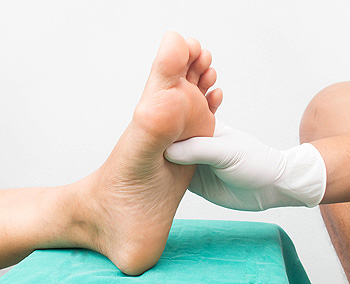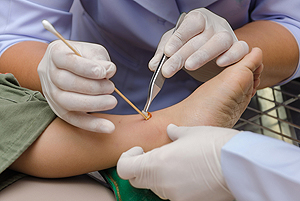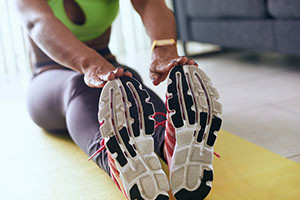Items filtered by date: September 2020
Symptoms of Peripheral Neuropathy
 Peripheral neuropathy is a disorder that causes a malfunction in the nerves that send signals from the rest of your body to the brain and spinal cord. Symptoms of peripheral neuropathy include a sharp, stabbing pain and numbness or weakness in the feet. You may feel a tingling sensation in the feet, a buzzing or shock, or a sensation similar to wearing a tight sock. Peripheral neuropathy can also cause symptoms throughout the whole body, such as thinning of the skin, a drop in blood pressure, digestive problems, and excessive sweating. If you are experiencing the symptoms of peripheral neuropathy, it is recommended that you see a podiatrist for treatment.
Peripheral neuropathy is a disorder that causes a malfunction in the nerves that send signals from the rest of your body to the brain and spinal cord. Symptoms of peripheral neuropathy include a sharp, stabbing pain and numbness or weakness in the feet. You may feel a tingling sensation in the feet, a buzzing or shock, or a sensation similar to wearing a tight sock. Peripheral neuropathy can also cause symptoms throughout the whole body, such as thinning of the skin, a drop in blood pressure, digestive problems, and excessive sweating. If you are experiencing the symptoms of peripheral neuropathy, it is recommended that you see a podiatrist for treatment.
Neuropathy
Neuropathy can be a potentially serious condition, especially if it is left undiagnosed. If you have any concerns that you may be experiencing nerve loss in your feet, consult with one of our podiatrists from New Tampa Foot & Ankle. Our doctors will assess your condition and provide you with quality foot and ankle treatment for neuropathy.
What Is Neuropathy?
Neuropathy is a condition that leads to damage to the nerves in the body. Peripheral neuropathy, or neuropathy that affects your peripheral nervous system, usually occurs in the feet. Neuropathy can be triggered by a number of different causes. Such causes include diabetes, infections, cancers, disorders, and toxic substances.
Symptoms of Neuropathy Include:
- Numbness
- Sensation loss
- Prickling and tingling sensations
- Throbbing, freezing, burning pains
- Muscle weakness
Those with diabetes are at serious risk due to being unable to feel an ulcer on their feet. Diabetics usually also suffer from poor blood circulation. This can lead to the wound not healing, infections occurring, and the limb may have to be amputated.
Treatment
To treat neuropathy in the foot, podiatrists will first diagnose the cause of the neuropathy. Figuring out the underlying cause of the neuropathy will allow the podiatrist to prescribe the best treatment, whether it be caused by diabetes, toxic substance exposure, infection, etc. If the nerve has not died, then it’s possible that sensation may be able to return to the foot.
Pain medication may be issued for pain. Electrical nerve stimulation can be used to stimulate nerves. If the neuropathy is caused from pressure on the nerves, then surgery may be necessary.
If you have any questions, please feel free to contact our office located in Wesley Chapel, FL . We offer the newest diagnostic and treatment technologies for all your foot care needs.
It's Time for Beautiful Feet
Signs and Symptoms of Athlete's Foot
 Tinea pedis, or athlete’s foot, as it is more often called, is a fungal infection of the skin on the feet. There are many symptoms of this very common condition, and it’s important to be aware of them so that you can identify a potential fungal infection early and begin treatment. Itching, stinging, or burning on the soles of your feet and between your toes, as well as dry, cracking and peeling skin, are often the most recognizable signs of athlete’s foot. You may also have itchy foot blisters or raw skin on your feet. Your toenails can also get infected and may pull away from the nail bed or become discolored, thick, and crumbly. If you suspect that you have athlete’s foot, make sure that you see a podiatrist for diagnosis and treatment.
Tinea pedis, or athlete’s foot, as it is more often called, is a fungal infection of the skin on the feet. There are many symptoms of this very common condition, and it’s important to be aware of them so that you can identify a potential fungal infection early and begin treatment. Itching, stinging, or burning on the soles of your feet and between your toes, as well as dry, cracking and peeling skin, are often the most recognizable signs of athlete’s foot. You may also have itchy foot blisters or raw skin on your feet. Your toenails can also get infected and may pull away from the nail bed or become discolored, thick, and crumbly. If you suspect that you have athlete’s foot, make sure that you see a podiatrist for diagnosis and treatment.
Athlete’s foot is an inconvenient condition that can be easily reduced with the proper treatment. If you have any concerns about your feet and ankles, contact one of our podiatrists from New Tampa Foot & Ankle. Our doctors will treat your foot and ankle needs.
Athlete’s Foot: The Sole Story
Athlete's foot, also known as tinea pedis, can be an extremely contagious foot infection. It is commonly contracted in public changing areas and bathrooms, dormitory style living quarters, around locker rooms and public swimming pools, or anywhere your feet often come into contact with other people.
Solutions to Combat Athlete’s Foot
- Hydrate your feet by using lotion
- Exfoliate
- Buff off nails
- Use of anti-fungal products
- Examine your feet and visit your doctor if any suspicious blisters or cuts develop
Athlete’s foot can cause many irritating symptoms such as dry and flaking skin, itching, and redness. Some more severe symptoms can include bleeding and cracked skin, intense itching and burning, and even pain when walking. In the worst cases, Athlete’s foot can cause blistering as well. Speak to your podiatrist for a better understanding of the different causes of Athlete’s foot, as well as help in determining which treatment options are best for you.
If you have any questions please feel free to contact our office located in Wesley Chapel, FL . We offer the newest diagnostic and treatment technologies for all your foot and ankle needs.
Should I Gradually Increase My Running Mileage?
The warm months of the year may encourage people to pursue the sport of running. This is considered to be a popular hobby, and methods can be implemented that may help to prevent running injuries from occurring. These can consist of wearing shoes that fit correctly, alternating between running and walking, and gradually increasing the mileage that is run each week. Research has indicated that it is best to let your feet rest between runs, and drinking plenty of water may help to increase hydration. There are numerous injuries that can happen to the feet while running, and it is suggested to consult with a podiatrist for additional ways on how to prevent running injuries.
All runners should take extra precaution when trying to avoid injury. If you have any concerns about your feet, contact one of our podiatrists of New Tampa Foot & Ankle. Our doctors will treat your foot and ankle needs.
How to Prevent Running Injuries
There are a lot of mistakes a runner can make prior to a workout that can induce injury. A lot of athletes tend to overstretch before running, instead of saving those workouts for a post-run routine. Deep lunges and hand-to-toe hamstring pulls should be performed after a workout instead of during a warmup. Another common mistake is jumping into an intense routine before your body is physically prepared for it. You should try to ease your way into long-distance running instead of forcing yourself to rush into it.
More Tips for Preventing Injury
- Incorporate Strength Training into Workouts - This will help improve the body’s overall athleticism
- Improve and Maintain Your Flexibility – Stretching everyday will help improve overall performance
- “Warm Up” Before Running and “Cool Down” Afterward – A warm up of 5-10 minutes helps get rid of lactic acid in the muscles and prevents delayed muscle soreness
- Cross-Training is Crucial
- Wear Proper Running Shoes
- Have a Formal Gait Analysis – Poor biomechanics can easily cause injury
If you have any questions, please feel free to contact our office located in Wesley Chapel, FL . We offer the newest diagnostic and treatment technologies for all your foot care needs.
Heel Pain Can Be Treated!
Why Are Diabetics More Susceptible to Foot Wounds?
 Foot wounds or foot ulcers can become serious issues for diabetics. About 15% of people with diabetes will develop wounds on their feet. These wounds may be difficult to detect and are typically slow to heal. Many diabetics suffer from peripheral neuropathy, a loss of sensation in the lower limbs. This loss of sensation makes it hard to know if you have injured your foot. A cut, scrape, sore, or a more serious injury like a burn or puncture, can go undetected. The lack of awareness of the injury can be a big problem because diabetics also frequently suffer from poor circulation to the lower limbs. Poor circulation leads to slower healing and can make you more prone to infection. If you have diabetes, it is important to inspect your feet for wounds daily and to get treatment for your wounds as soon as possible. A podiatrist can help you care for your feet and offer treatment and prevention strategies that will work for you.
Foot wounds or foot ulcers can become serious issues for diabetics. About 15% of people with diabetes will develop wounds on their feet. These wounds may be difficult to detect and are typically slow to heal. Many diabetics suffer from peripheral neuropathy, a loss of sensation in the lower limbs. This loss of sensation makes it hard to know if you have injured your foot. A cut, scrape, sore, or a more serious injury like a burn or puncture, can go undetected. The lack of awareness of the injury can be a big problem because diabetics also frequently suffer from poor circulation to the lower limbs. Poor circulation leads to slower healing and can make you more prone to infection. If you have diabetes, it is important to inspect your feet for wounds daily and to get treatment for your wounds as soon as possible. A podiatrist can help you care for your feet and offer treatment and prevention strategies that will work for you.
Wound care is an important part in dealing with diabetes. If you have diabetes and a foot wound or would like more information about wound care for diabetics, consult with one of our podiatrists from New Tampa Foot & Ankle. Our doctors will assess your condition and provide you with quality foot and ankle treatment.
What Is Wound Care?
Wound care is the practice of taking proper care of a wound. This can range from the smallest to the largest of wounds. While everyone can benefit from proper wound care, it is much more important for diabetics. Diabetics often suffer from poor blood circulation which causes wounds to heal much slower than they would in a non-diabetic.
What Is the Importance of Wound Care?
While it may not seem apparent with small ulcers on the foot, for diabetics, any size ulcer can become infected. Diabetics often also suffer from neuropathy, or nerve loss. This means they might not even feel when they have an ulcer on their foot. If the wound becomes severely infected, amputation may be necessary. Therefore, it is of the upmost importance to properly care for any and all foot wounds.
How to Care for Wounds
The best way to care for foot wounds is to prevent them. For diabetics, this means daily inspections of the feet for any signs of abnormalities or ulcers. It is also recommended to see a podiatrist several times a year for a foot inspection. If you do have an ulcer, run the wound under water to clear dirt from the wound; then apply antibiotic ointment to the wound and cover with a bandage. Bandages should be changed daily and keeping pressure off the wound is smart. It is advised to see a podiatrist, who can keep an eye on it.
If you have any questions, please feel free to contact our office located in Wesley Chapel, FL . We offer the newest diagnostic and treatment technologies for all your foot care needs.



